2025.04.08
Spring in Japan Is More Than Just Cherry Blossoms: Discover Hana Matsuri and Kaiseki Cuisine
By Chef Yuuki Tanaka, owner of Ise Sueyoshi — Tripadvisor Best of the Best: Japan #1, World #12.(source).

What You’ll Learn in This Article
• What Hanamatsuri is and how it’s celebrated in Japan
• The cultural and spiritual role of amacha (sweet hydrangea tea)
• How spring festivals in Japan go beyond cherry blossoms
• How Ise Sueyoshi incorporates Hanamatsuri themes into its kaiseki cuisine
• Where you can experience this seasonal celebration in Tokyo
Beyond Sakura Magic
When we think of spring in Japan, cherry blossoms immediately come to mind. Every year, thousands of travelers from around the world flock to Japan to witness the fleeting beauty of these delicate pink petals. The sight of sakura drifting gently through the air feels almost like a momentary spell cast over the landscape.
Yet beyond their ephemeral charm lies a deeper, more profound season—one that quietly breathes beneath the surface of Japan’s iconic spring. While cherry blossoms may symbolize the beginning of this season, they are merely the prologue to a much grander cultural narrative.
In this journey, we invite you to look beyond the blossoms and discover the spiritual essence of Japanese spring through its sacred traditions and refined culinary arts. By exploring Hana Matsuri, the Buddhist celebration of Buddha’s birth, and the vibrant world of seasonal Kaiseki cuisine, we hope to guide you to the true heart of spring in Japan.
Let us open the door together to a lesser-known, yet deeply enchanting story of spring—one that begins after the last cherry blossom touches the ground.
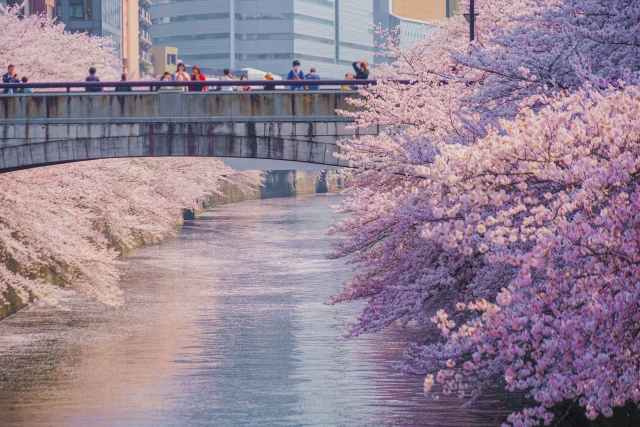
Sacred Flower Festival
Beyond the story of cherry blossoms lies another facet of Japan’s spring — a symbolic and spiritual tradition known as Hana Matsuri, or the Flower Festival, held annually on April 8th. Officially called Kanbutsu-e, this centuries-old celebration honors the birth of Buddha, the founder of Buddhism.
In Japan, Buddhism is less about strict doctrinal belief and more about a quiet, ever-present influence woven into daily life, seasonal customs, and cultural consciousness. From small protective charms carried for health or safety, to the ringing of temple bells (Joya no Kane) on New Year’s Eve, Buddhist traditions gently shape the rhythm of Japanese life. Take Obon, for example — a summer period during which families honor their ancestors by visiting graves. It’s not merely a religious observance, but a heartfelt time for family connection and remembrance.
Hana Matsuri is another of these deeply rooted customs, preserved with care at temples across Japan. On this day, temples set up a beautifully decorated miniature pavilion called Hanamido, adorned with colorful seasonal flowers — a symbolic re-creation of the sacred garden where Buddha was said to have been born. At its center stands a tiny statue of the newborn Buddha, known as the Tanjoubutsu, pointing one hand toward the sky and the other toward the earth, representing his arrival into the world.
Unlike the exuberant energy of cherry blossom season or the lively atmosphere of summer festivals, Hana Matsuri radiates a serene calm. Visitors, often families with children, gather in a gentle and reflective mood. There is no loud celebration, but rather a quiet, profound beauty. It is in this peacefulness that one encounters the depth of Japanese spiritual culture.
In the overwhelming spotlight of sakura, this sacred flower festival may be easily overlooked by travelers. But for those seeking a deeper, more spiritual connection to Japan’s spring, Hana Matsuri offers an unforgettable experience — not flashy, but deeply resonant. It’s a rare window into the soul of a culture that quietly honors beauty, impermanence, and reverence for life.
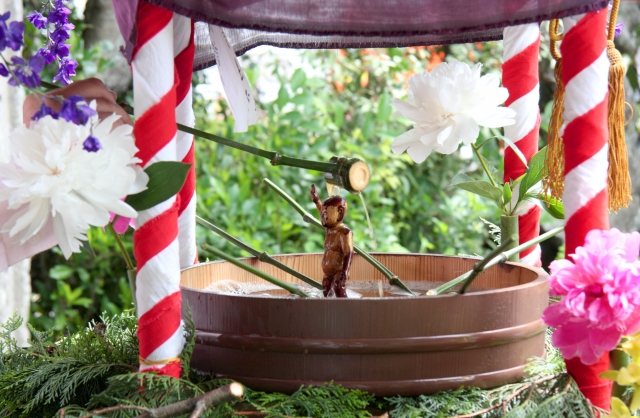
Sweet Tea Ritual
Amid the serene scenes of Hana Matsuri, another quiet and sacred tradition comes to life — one that revolves around a special springtime drink known as “amacha”, or sweet tea.
This tea, unique to the season, is made by fermenting the leaves of a specific type of hydrangea called amachazuru. Unlike ordinary teas, amacha has a gentle, natural sweetness — delicate and soothing, much like the soft light of spring itself. Its fragrance evokes the vitality of young leaves and the quiet heartbeat of life that pulses through Japan’s springtime.
According to ancient legend, when the Buddha was born, sweet rain (kanro) poured down from the heavens. The act of pouring amacha over the statue of the newborn Buddha — a key ritual during Hana Matsuri — is far more than a symbolic gesture. It represents a heartfelt prayer for purification, health, and especially the healthy growth of children. In that quiet moment, as visitors ladle the sacred tea over the Tanjoubutsu statue, a deep reverence for life and hope for the future are quietly, yet powerfully, expressed.
On this special day, those who visit a temple are fortunate enough to taste this rare tea — an experience that goes far beyond flavor. It is a sensory journey that embodies the spiritual essence of Japan and its deep respect for nature. With a single sip of amacha, one can experience the hidden richness of Japanese spring — something far more enduring than even the fleeting beauty of cherry blossoms.
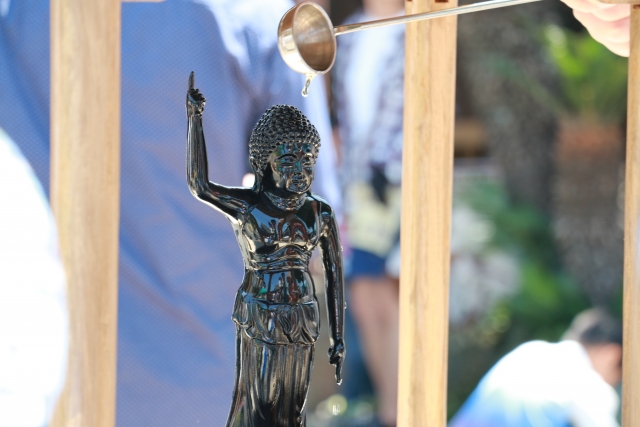
Nature’s Spring Palette
The sacred theme of Hana Matsuri—the celebration of Buddha’s birth and the sweet tea ritual that symbolizes a blessing of life—resonates deeply with Japan’s springtime essence: the season of rebirth. As the long slumber of winter ends, nature awakens. From beneath the soil and beneath the sea, vibrant, life-filled ingredients begin to emerge. These treasures are nature’s brushstrokes, painting the landscape of spring and adorning Japanese dining tables with their vibrant beauty.
One of the most cherished concepts in Japanese culinary culture is “shun”, or seasonality. But “shun” is more than just a time when an ingredient is available—it refers to the brief moment when a food’s flavor, texture, and nutrients are at their peak, offering the truest expression of that ingredient. The Japanese have long celebrated the changing seasons by savoring their subtle transitions: the “hashiri”, or early arrivals, bring a light freshness; the “sakari”, or full season, delivers peak flavor and abundance; and the “nagori”, or final offerings, are imbued with depth, richness, and a sense of seasonal nostalgia. Even in a modern age where ingredients can be sourced year-round, the reverence for these fleeting seasonal moments remains at the heart of Japanese cuisine.
At the forefront of spring flavors is the iconic bamboo shoot (takenoko). Bursting from the earth in a powerful gesture of new life, freshly harvested bamboo shoots are tender, slightly sweet, and have a delightful crispness. Their youthful earthiness is a true taste of spring’s energy.

Mountain vegetables (sansai) also mark the season’s arrival—delicacies like fuki no tō (butterbur buds), kogomi (ostrich fern), tara no me (angelica tree shoots), and urui (hosta shoots) bring their signature bitterness. This bitterness is not just a flavor, but a cleansing force—traditionally believed to help the body shake off the stagnation of winter and awaken to spring. Their vivid greens dazzle the eye and echo the vitality of life renewed.

From the sea, madai (red sea bream) is at its prime. Known poetically as sakura-dai due to its pink hues and seasonal alignment with cherry blossoms, it is prized for its delicate yet flavorful flesh, firm and subtly fatty. Clams (hamaguri), too, are springtime favorites. Fed by nutrient-rich meltwater from the mountains, their plump flesh yields a broth both gentle and deeply nourishing—an essential element of springtime comfort in Japan.
These spring ingredients—pale yellow bamboo shoots, vibrant green sansai, cherry-colored sea bream, and the soft white of clams—are nature’s spring palette. Their aromas, textures, and flavors form a multisensory symphony of renewal. And each of these ingredients becomes the cornerstone of Kaiseki cuisine, Japan’s refined culinary art that celebrates not only taste but the spirit of the season itself.
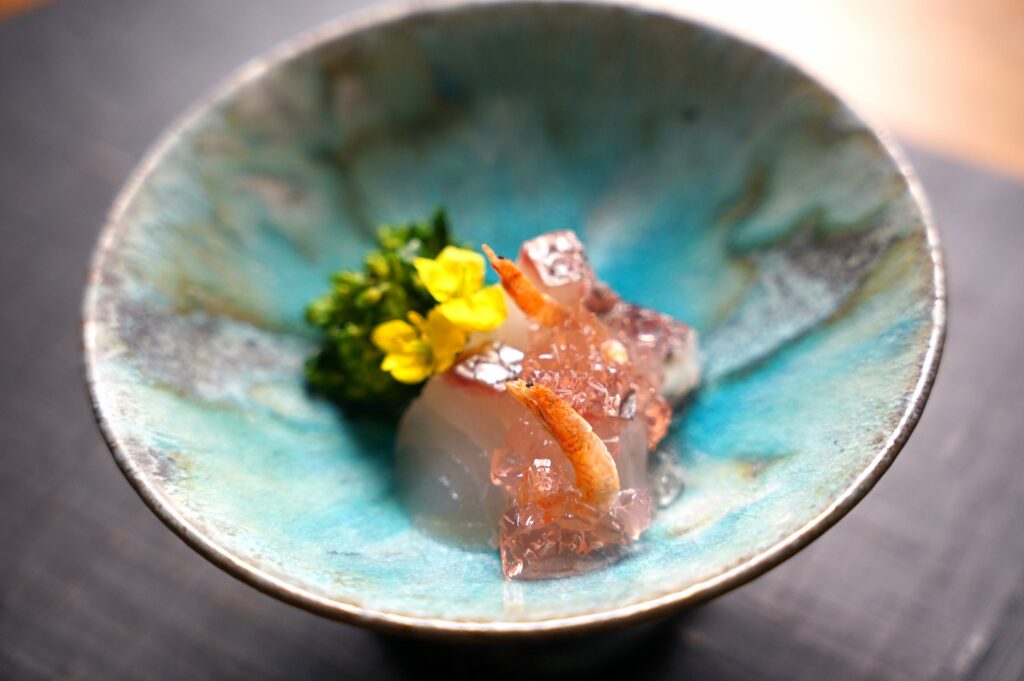
Sansai: The Sacred Spring Ritual of Wild Mountain Vegetables at a Hidden Tokyo Kaiseki Restaurant
Kaiseki’s Spring Symphony
The strength of bamboo shoots, the pleasant bitterness of mountain vegetables, the delicate flavor of red sea bream, and the savory depth of clams—these vibrant expressions of spring’s natural bounty come together in perfect harmony on the grand stage of Kaiseki cuisine, the pinnacle of Japan’s culinary tradition. Kaiseki is far more than a multi-course meal—it is an immersive experience that weaves together deep respect for seasonality, the aesthetics of nature, and the essence of Japanese hospitality.
In this culinary art, the chef is both conductor and artist, drawing inspiration from the palette of spring. Each ingredient is treated as a voice to be heard, its story and character revealed through techniques that enhance its natural qualities. The chef listens closely, adapting preparation methods to unlock the ingredient’s peak flavor—delicate, bold, and always intentional. Every dish in a Kaiseki meal is a chapter in a larger narrative, guiding the guest through a poetic journey of the season.
Spring Kaiseki expresses this theme in every detail. Presentation is a celebration in itself. Pale-pink ceramic plates, fresh green Oribe ware, and translucent glassware that evokes spring haze are carefully chosen to mirror the spirit of the season. Bamboo shoots, bracken, and other spring ingredients are arranged to resemble new growth in the wild, often accompanied by sakura branches or yellow rapeseed blossoms. These dishes are more than meals—they are landscapes of spring, painted on porcelain.
Preparation techniques are designed to preserve the freshness and subtlety of spring ingredients. For example, freshly dug bamboo shoots may be simmered gently with wakame seaweed in a dish called wakatake-ni, while mountain vegetables are lightly tempura-fried or served as simple ohitashi to highlight their refreshing bitterness. Red sea bream—sakura-dai—might be lightly cured with cherry leaves for a dish known as sakura-jime, enhancing its visual and flavor appeal. Clams, rich in umami, are transformed into a delicate clear soup (osuimono), allowing their full depth to be appreciated. Steaming, grilling, marinating—each method is chosen not for show, but out of deep reverence for the ingredient and the season.
Even the structure of the meal itself tells a seasonal story. A Kaiseki course traditionally begins with an aperitif, followed by a small appetizer (sakizuke), a seasonal soup (wanmono), sashimi (mukozuke), grilled dish (yakimono), simmered dish (takiawase), rice and miso soup (shokuji), and dessert (mizumono). This elegant progression mirrors spring’s journey from early bloom to full blossom and eventually to its fading elegance. Each dish heightens anticipation for the next, forming a seamless symphony of spring.
Enjoying a Kaiseki meal aligns deeply with the spirit of Hana Matsuri, celebrating purity, gratitude, and renewal. Kaiseki respects ingredients by using them to their fullest, expressing reverence for nature’s gifts. In the quiet ambiance of the dining room, the guest sharpens their senses, absorbing not only the flavors but the intention and seasonality infused into each creation. It is more than a meal—it is a moment of mindfulness, a cultural expression, and a celebration of beauty and thoughtfulness. Through Kaiseki, the essence of Japanese spring is whispered in the most refined and eloquent way.
Read more: What is Kaiseki cuisine?
Guided Culinary Storytelling
Kaiseki cuisine reflects the vibrant breath of spring in every dish. The seasonal essence, carefully selected ingredients at the peak of their freshness, and the chef’s refined technique and artistic vision come together like a symphony composed by nature itself. Yet, to truly appreciate this culinary art form, tasting alone may not suffice. Understanding the stories behind each dish—where the ingredients come from, why they are in season now, the thought behind the cooking method, and the cultural significance of the plating and tableware—adds layers of depth to the experience.
For first-time Kaiseki diners or guests visiting from abroad, deciphering these nuances can be challenging. That’s why the presence of a knowledgeable and passionate guide becomes essential. The best Kaiseki experiences are often enriched by chefs or well-trained staff who act as narrators, unveiling the stories woven into each course. Through their explanations, a dish transforms from “delicious food” into a cultural narrative for the senses.
At restaurants like Ise Sueyoshi, which value true omotenashi (the spirit of Japanese hospitality), the entire meal becomes a storytelling journey. Each course is presented not just as food, but as a chapter in a larger seasonal tale. The chef and staff share stories—in English—about the origin of the ingredients, the farmers or fishermen who brought them to life, the history and meaning behind their use, and why a certain cooking method was chosen for that particular time of year.
This guided experience opens up the senses of international travelers. Learning the names and meanings behind mountain vegetables, for example, turns unfamiliar ingredients into approachable delights. Understanding the seasonal motifs painted on a serving dish enhances not just visual enjoyment but also cultural connection. Knowing how the chef thoughtfully adjusted the heat or combined specific flavors offers insight into the precision and intention behind each dish, deepening respect and admiration.
Moreover, true omotenashi is never one-size-fits-all—it’s about heartfelt attentiveness to each guest. At Ise Sueyoshi, we go beyond accommodating allergies or dietary preferences. We embrace and welcome guests with restrictions such as vegetarian, vegan, or gluten-free diets, striving to create dishes that align with their values and needs without compromising authenticity or depth. For those searching online for a “Tokyo vegetarian restaurant,” we want to be a place where they feel safe, understood, and able to fully experience the elegance of Japanese cuisine.
We believe that tailoring the experience to the guest’s needs—whether it’s ingredient preference, food philosophy, or cultural curiosity—transforms a meal into a deeply personal and memorable moment. This thoughtful care and warm communication build a trust that lasts beyond the meal.
Beyond the beauty of cherry blossoms lies the profound depth of Japanese spring. If there is a way to experience it at its most meaningful and enriching, it may be through this guided storytelling journey. From the spiritual stillness of Hana Matsuri to the vitality of seasonal ingredients and the refinement of Kaiseki artistry, this is a cultural immersion through food. And if you are seeking not just a meal, but a lasting story of spring in Japan, we invite you to open that door.
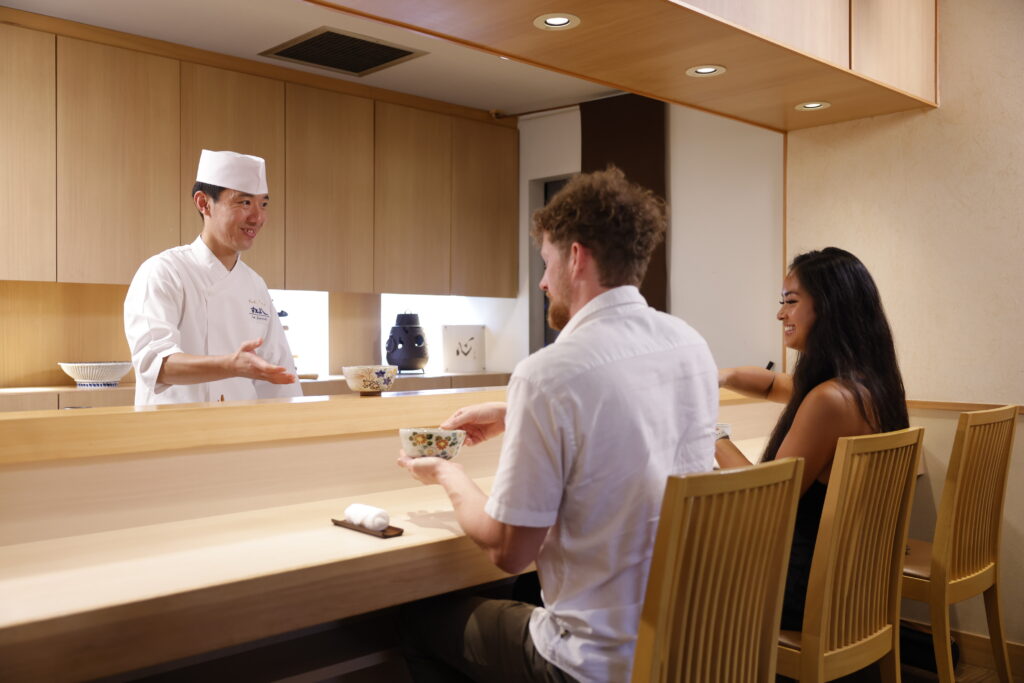
For more about our vegan and gluten-free philosophy, please visit this page.
We are proud to continue delivering an exceptional dining experience that earned us the Tripadvisor Travelers’ Choice Best of the Best 2024 award, ranking among the Best Restaurants in Tokyo. Our commitment to excellence in service and our dedication to offering the finest kaiseki dining experience in Tokyo remain unwavering. Discover more about our journey to becoming one of the best restaurants in the city[here].

Visit Ise Sueyoshi
Location: Conveniently located 12 minutes from Roppongi Station and 8 minutes from Hiroo Station.
Hours: Open 5:00 PM – 10:00 PM, reservations only. Closed on Sundays and Mondays.
Book Your Experience ☟
Conclusion
At Ise Sueyoshi, we humbly invite you to experience a dining journey that caters to all dietary needs. Whether you’re vegan, halal, or have specific preferences, we are here to create a memorable and inclusive dining experience for you, especially for special occasions like a honeymoon.
Recommended Blog Posts
On our blog, we offer further insights into Tokyo’s rich food culture and the unique culinary experiences we provide at Ise Sueyoshi. Be sure to check out these recommended posts:
@isesueyoshi
o 🏆 Awarded the prestigious Best Luxury Restaurant by TripAdvisor
o 🌍 Ranked 2nd worldwide, 1st in Japan, and 1st in Asia
o ⭐ Google rating of 4.9 (as of 2024)
o ✅ Vegan-friendly
o ✅ Halal selections
o ✅ Gluten-free options
o ✅ Vegetarian delights
o ✅ Pork-free choices
o ✅ Perfect for pescatarians
o 🌈 Welcoming and inclusive environment for LGBTQ guests
o 🚃 Just a 12-minute walk from Roppongi Station or 8-minutes from Hiroo Station
o ⏰ 5:00 PM – 10:00 PM (reservations-only)
o 📅 Closed on Sun and Mon
